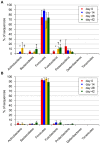Effect of oral administration of metronidazole or prednisolone on fecal microbiota in dogs
- PMID: 25229475
- PMCID: PMC4168260
- DOI: 10.1371/journal.pone.0107909
Effect of oral administration of metronidazole or prednisolone on fecal microbiota in dogs
Abstract
Gastrointestinal microbiota have been implicated in the pathogenesis of various gastrointestinal disorders in dogs, including acute diarrhea and chronic enteropathy. Metronidazole and prednisolone are commonly prescribed for the treatment of these diseases; however, their effects on gastrointestinal microbiota have not been investigated. The objective of this study was to evaluate the effects of these drugs on the gastrointestinal microbiota of dogs. Metronidazole was administered twice daily at 12.5 mg/kg to a group of five healthy dogs, and prednisolone at 1.0 mg/kg daily to a second group of five healthy dogs for 14 days. Fecal samples were collected before and after administration (day 0 and 14), and 14 and 28 days after cessation (day 28 and 42). DNA was extracted, and the bacterial diversity and composition of each sample were determined based on 16S ribosomal RNA (rRNA) gene sequences using next-generation sequencing (Illumina MiSeq). In the group administered metronidazole, bacterial diversity indices significantly decreased at day 14, and recovered after the cessation. Principal coordinates analysis and hierarchical dendrogram construction based on unweighted and weighted UniFrac distance matrices revealed that bacterial composition was also significantly altered by metronidazole at day 14 compared with the other time points. The proportions of Bacteroidaceae, Clostridiaceae, Fusobacteriaceae, Lachnospiraceae, Ruminococcaceae, Turicibacteraceae, and Veillonellaceae decreased, while Bifidobacteriaceae, Enterobacteriaceae, Enterococcaceae, and Streptococcaceae increased at day 14 and returned to their initial proportions by day 42. Conversely, no effect of prednisolone was observed on either the bacterial diversity or composition. Reducing pathogenic bacteria such as Fusobacteria and increasing beneficial bacteria such as Bifidobacterium through the administration of metronidazole may be beneficial for promoting gastrointestinal health; however, further investigations into the effects on diseased dogs are needed.
Conflict of interest statement
Figures




References
-
- Hooper LV, Wong MH, Thelin A, Hansson L, Falk PG, et al. (2001) Molecular analysis of commensal host-microbial relationships in the intestine. Science 291: 881–884. - PubMed
-
- Hooda S, Minamoto Y, Suchodolski JS, Swanson KS (2012) Current state of knowledge: the canine gastrointestinal microbiome. Anim Health Res Rev 13: 78–88. - PubMed
-
- Mackie RI, Sghir A, Gaskins HR (1999) Developmental microbial ecology of the neonatal gastrointestinal tract. Am J Clin Nutr 69: 1035S–1045S. - PubMed
-
- Kanauchi O, Matsumoto Y, Matsumura M, Fukuoka M, Bamba T (2005) The beneficial effects of microflora, especially obligate anaerobes, and their products on the colonic environment in inflammatory bowel disease. Curr Pharm Des 11: 1047–1053. - PubMed
-
- Sunvold GD, Fahey GC Jr, Merchen NR, Reinhart GA (1995) In vitro fermentation of selected fibrous substrates by dog and cat fecal inoculum: influence of diet composition on substrate organic matter disappearance and short-chain fatty acid production. J Anim Sci 73: 1110–1122. - PubMed
Publication types
MeSH terms
Substances
LinkOut - more resources
Full Text Sources
Other Literature Sources
Medical

